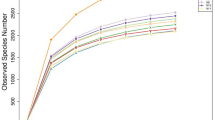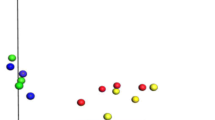Abstract
The rumen content of four Yunnan Yellow Cattle (Bos taurs) were collected to determine the bacteria diversity by using 16S rRNA gene sequence analysis. A total of 129 sequences were examined and the sequences were referred as 107 OTU (Operational Taxonomy Unit) according to the similarity level of 97% in gene sequence. Similarity analysis revealed that Yunnan Yellow Cattle had 12 sequences (10 OTU) shared 97% or greater similarity with cultured rumen bacteria Butyrivibrio fibrisolvens, Succiniclasticum ruminis, Ruminococcus bromii, Clostridium proteoclasticum, Ruminococcus flavefaciens, Pseudobutyrivibrio ruminis, Jeotgalicoccus psychrophilus, and Prevotella ruminicola, which accounting for 9.3% of the total clones (9.2% of the total OTU). The further 12 sequences (9 OTU) shared 90–97% similarity with cultured bacteria Clostridium aminobutyricum, butyrate-producing bacterium, Schwartzia succinivorans, Prevotella ruminicola, Eubacterium ruminantium, Ruminococcus albus, and Clostridium termitidis, also accounting for 9.3% of the total sequences (8.3% of the total OTU). The remaining 105 sequences (90 OTU) shared less than 90% similarity with cultured bacteria, accounting for 81.4% of the total sequences (82.5% of the total OTU). According to the phylogenetic analysis, all sequences were phylogenetically placed within phyla of low G+C subdivision (accounting for 72.1 and 72.5% of the total clones and OTU, respectively) and CFB subdivision (Cytophaga-Flexibacter-Bacteroides; accounting for 27.9 and 27.5% of the total clones and OTU, respectively). Among the examined clones, rare bacteria Jeotgalicoccus psychrophilus was detected in the rumen of cattle.



Similar content being viewed by others
References
Hungate RE (1969) A roll tube method for cultivation of strict anaerobes. In: Norris JR, Ribbons DW (eds) Methods in microbiology, vol 3B. Academic Press, London and New York, pp 117–132
Dehority BA, Tirabasso PA, Grifo AP (1989) Most-probable-number procedures for enumerating ruminal bacteria, including the simultaneous estimation of total and cellulolytic numbers in one medium. Appl Environ Microbiol 55:2789–2792
Amann RI, Ludwig W, Schleifer KH (1995) Phylogenetic identification and in situ detection of individual microbial cells without cultivation. Microbiol Rev 59:143–169
Zoetendal EG, Collier CT, Koike S, Mackie RI, Gaskins HR (2004) Molecular ecological analysis of the gastrointestinal microbiota: a review. J Nutr 134:465–472
Krause DO, Denman SE, Mackie RI, Morrison M, Rae AL, Attwood GT, McSweeney CS (2003) Opportunities to improve fiber degradation in the rumen: microbiology, ecology, and genomics. FEMS Microbiol Rev 27:663–693
Shin EC, Choi BR, Lim WJ, Hong SY, An CL, Cho KM, Kim YK, An JM, Kang JM, Lee SS, Kim H, Yun HD (2004) Phylogenetic analysis of archaea in three fractions of cow rumen based on the 16S rDNA sequence. Anaerobe 10:313–319
Hungate RE (1966) The rumen and its microbes. Academic Press, New York
Bryant MP, Burkey LA (1953) Cultural methods and some characteristics of some of the numerous groups of bacteria in the bovine rumen. J Dairy Sci 36:205–217
Krause DO, Russell JB (1996) How many ruminal bacteria are there? J Dairy Sci 79:1467–1475
Deng W, Xi D, Mao H, Wanapat M (2008) The use of molecular techniques based on ribosomal RNA and DNA for rumen microbial ecosystem studies: a review. Mol Biol Rep 35:265–274
Zhang H, Chen L (2010) Phylogenetic analysis of 16S rRNA gene sequences reveals distal gut bacterial diversity in wild wolves (Canis lupus). Mol Biol Rep 37:4013–4022
Stahl DA, Flesher B, Mansfield HR, Montgomery L (1988) Use of phylogenetically based hybridization probes for studies in ruminal microbial ecology. Appl Environ Microbiol 54:1079–1084
Koike S, Yoshitani S, Kobayashi Y, Tanaka K (2003) Phylogenetic analysis of fiber-associated rumen bacterial community and PCR detection of uncultured bacteria. FEMS Microbiol Lett 229:23–30
Kocherginskaya SA, Aminov RI, White BA (2001) Analysis of the rumen bacterial diversity under two different diet conditions using denaturing gradient gel electrophoresis, random sequencing, and statistically ecology approaches. Anaerobe 7:119–134
Leng J, Zhong X, Zhu RJ, Yang SL, Gou X, Mao HM (2011) Assessment of protozoa in Yunnan Yellow Cattle rumen based on the 18S rRNA sequences. Mol Biol Rep 38:577–585
Zhao G, YU M, Zhang Y, Yang GR, Fu MF, Li JP, Yang XC, Yang S, Huang BZ (2009) The investigation of growth and production performances in Yunnan Yellow Cattle. Anim Husb Vet Med 41:65–67 (in Chinese)
Qi KX, Zhang JC, Wang AK, Wang J, Yang SP, Huang BZ, Yuan XP (2009) The survey and analysis of growth and reproductive performances in Yunnan Yellow Cattle. China Herbiv 29:67–68 (in Chinese)
Tian YB, Ge CR, Guo CY, Xiao WJ (1998) Relationship between breed characteristics and ecological environment of Yunnan Yellow Cattle. J Yellow Cattle Sci 24:50–54 (in Chinese)
Weisburg WG, Barns SM, Pelletier DA, Lane DJ (1991) 16S ribosomal DNA amplification for phylogenetic study. J Bacteriol 173:697–703
Maidak BL, Cole JR, Lilburn TG, Parker CT Jr, Saxman PR, Farris RJ, Garrity GM, Olsen G, Schmidt TM, Tiedje JM (2001) The RDP-II (ribosomal database project). Nucleic Acids Res 29:173–174
Altschul SF, Madden TL, Schaffer AA, Zhang J, Zhang Z, Miller W, Lipman DJ (1997) Gapped BLAST and PSI-BLAST: a new generation of protein database search programs. Nucleic Acids Res 25:3389–3402
Thompson JD, Gibson TJ, Plewniak F, Jeanmougin F, Higgins DG (1997) The Clustal_X windows interface: flexible strategies for multiple sequence alignment aided by quality analysis tools. Nucleic Acids Res 25:4876–4882
Tamura K, Dudley J, Nei M, Kumar S (2007) MEGA4: molecular evolutionary genetics analysis (MEGA) software version 4.0. Mol Biol Evol 24:1596–1599
An D, Dong X, Dong Z (2005) Prokaryote diversity in the rumen of yak (Bos grunniens) and Jinnan cattle (Bos taurus) estimated by 16S rDNA homology analyses. Anaerobe 4:207–215
Yang LY, Chen J, Cheng XL, Xi DM, Yang SL, Deng WD, Mao HM (2009) Phylogenetic analysis of 16S rDNA sequences reveals rumen bacterial diversity in Yaks (Bos grunniens). Mol Biol Rep 37:553–562
Edward JE, McEwan NR, Travis AJ, Wallace RJ (2004) 16S rDNA library-based analysis of ruminal bacterial diversity. Antonie Van Leeuwenhoek 86:263–281
Tajima K, Aminov RI, Nagamine T, Ogata K, Nakamura M, Matusi H, Benno Y (1999) Rumen bacterial diversity as determined by sequence analysis of 16S rDNA libraries. FEMS Microbiol Ecol 29:159–169
Stackebrandt E, Goebel BM (1994) Taxonomic note: a place for DNA–DNA reassociation and 16S rRNA sequences analysis in the present species definition in bacteriology. Int J Syst Bacteriol 44:846–849
Sinha RN, Ranganathan B (1983) Cellulolytic bacteria in buffalo rumen. J Appl Bacteriol 54:1–6
Stewart CS, Flint HJ, Bryant MP (1997) The rumen bacteria. In: Hobson PN, Stewart CS (eds) The rumen microbial ecosystem, 2nd edn. Chapman and Hall, London, pp 10–72
Leng J, Xie L, Zhu RJ, Yang SL, Gou X, Li S, Mao HM. Dominant bacterial communities in the rumen of Gayals (Bos frontalis), Yaks (Bos grunniens) and Yunnan Yellow Cattle (Bos taurs) revealed by denaturing gradient gel electrophoresis (DGGE). Mol Biol Rep. doi:10.1007/s11033-010-0627-8
Wen Z, Morrison M, Wen ZZ (1997) Glutamate dehydrogenase activity profiles for type strains of ruminal Prevotella spp. Appl Environ Microbiol 63:3314–3317
Griswold KE, White BA, Mackie RI (1999) Diversity of extracellular proteolytic activities among Prevotella species from the rumen. Curr Microbiol 39:187–194
Lou J, Dawson KA, Strobel HJ (1996) Role of phosphorolytic cleavage in cellobiose and cellodextrin metabolism by the ruminal bacterium Prevotella ruminicola. Appl Environ Microbiol 62:770–1773
Avgustin G, Wallace RJ, Flint HJ (1997) Phenotypic diversity among ruminal isolates of Prevotella ruminicola: proposal of Prevotella brevis sp. nov., Prevotella bryantii sp. nov., and Prevotella albensis sp. nov., and redefinition of Prevotella ruminicola. Int J Syst Bacteriol 47:284–288
Flint HJ, Mcpherson EC, Bisset J (1989) Molecular cloning of genes from Ruminococcus flavefaciens encoding xylanase and β (1,3-1,4) glucanase activities. Appl Environ Microbiol 55:1230–1233
Kirby J, Martin JC, Daniel AS, Flint HJ (1997) Dockerin-like sequences in cellulases and xylanases from the rumen cellulolytic bacterium Ruminococcus flavefaciens. FEMS Microbiol Lett 149:213–219
Wina E, Muetzel S, Becker K (2006) The dynamics of major fibrolytic microbes and enzyme activity in the rumen in response to short- and long-term feeding of Sapindus rarak saponins. J Appl Microbiol 100:114–122
Forster RJ, Teather RM, Gong J, Deng SJ (1996) 16S rDNA analysis of Butyrivibrio fibrisolvens: phylogenetic position and relation to butyrate-producing anaerobic bacteria from the rumen of white-tailed deer. Lett Appl Microbiol 23:218–222
Forster RJ, Gong J, Teather RM (1997) Group-specific 16S rRNA hybridization probes for determinative and community structure studies of Butyrivibrio fibrisolvens in the rumen. Appl Environ Microbiol 63:1256–1260
Willems A, Amat-Marco M, Collins MD (1996) Phylogenetic analysis of Butyrivibrio strains reveals three distinct groups of species within the Clostridium subphylum of the Gram-positive bacteria. Int J Syst Bacteriol 46:95–199
van Gylswyk NO, Hippe H, Rainey FA (1996) Pseudobutyrivibrio ruminis gen. nov., sp. nov., a butyrate-producing bacterium from the rumen that closely resembles Butyrivibrio fibrisolvens in phenotype. Int J Syst Bacteriol 46:559–563
van Gylswyk NO, Hippe H, Rainey FA (1997) Schwartzia succinivorans gen. nov., sp. nov., another ruminal bacterium utilizing succinate as the sole energy source. Int J Syst Bacteriol 47:155–159
Taguchi H, Koike S, Kobayashi Y, Cann IKO, Karita S (2004) Partial characterization of structure and function of a xylanase gene from the rumen hemicellulolytic bacterium Eubacterium ruminantium. Anim Sci J 75:325–332
Kozakai K, Nakamura T, Kobayashi Y, Tanigawa T, Osaka I, Kawamoto S, Hara S (2007) Effect of mechanical processing of corn silage on in vitro ruminal fermentation, and in situ bacterial colonization and dry matter degradation. Can J Anim Sci 87:259–267
Dehority BA, Tirabasso PA (1998) Effect of ruminal cellulolytic bacterial concentrations on in situ digestion of forage cellulose. J Anim Sci 76:2905–2911
Wanapat M, Ngarmsang A, Korkhuntot S, Nontaso N, Wachirapakorn C, Beakes G, Rowlinson P (2000) A comparative study on the rumen microbial population of cattle and swamp buffalo raised under traditional village conditions in the Northeast of Thailand. Asian Aust J Anim Sci 13:918–921
Dehority BA, Orpin CG (1997) Development of and natural fluctuations in rumen microbial populations. In: Hobson PN, Stewart CS (eds) The rumen microbial ecosystem, 2nd edn. Chapman and Hall, London, pp 196–245
Acknowledgment
This study was financed by National Natural Science Foundation of China (grant no. 31060314, 30960256), Yunnan Natural Science Foundation (grant no. 2010CD059), the ‘‘863’’ Key Program of China (Grant No. 2008AA101001) and the Natural Science Foundation Major Research Project of Yunnan Province (grant no. 2004NG04) are acknowledged with gratitude.
Author information
Authors and Affiliations
Corresponding author
Additional information
J. Leng, Y. M. Cheng and C. Y. Zhang contributed equally to this study.
Rights and permissions
About this article
Cite this article
Leng, J., Cheng, Y.M., Zhang, C.Y. et al. Molecular diversity of bacteria in Yunnan yellow cattle (Bos taurs) from Nujiang region, China. Mol Biol Rep 39, 1181–1192 (2012). https://doi.org/10.1007/s11033-011-0848-5
Received:
Accepted:
Published:
Issue Date:
DOI: https://doi.org/10.1007/s11033-011-0848-5




